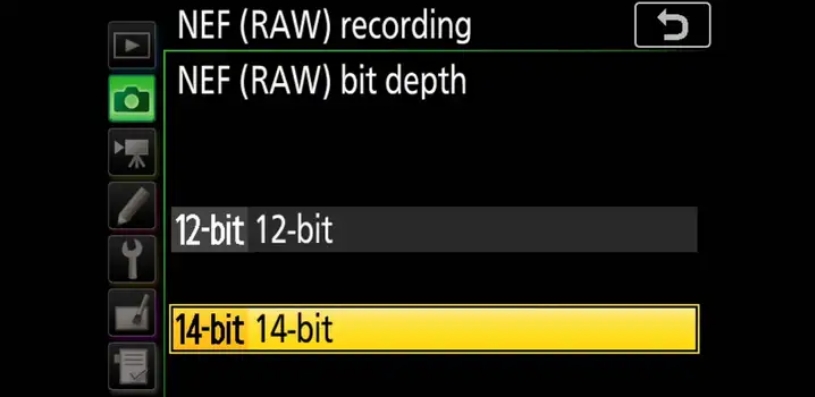Is the bit depth of PNG the same thing as the bit depth of a camera RAW?
PNG, BMP, GIF, JPEG, TIFF, HEIF... All these image file formats, whether 8-bit, 24-bit, or 32-bit, are based on CIE color, which in academic terms is called "conforming to the Luther observation conditions." RAW, however, does not conform to Luther observation, meaning RAW does not record color (CIE XYZ). The process of mapping RAW to color is called CCM, and this process is not mathematically deterministic.
The above explanation might seem a bit abstract, so let's make it more concrete. Replace PNG with TIFF files—some Nikon models can output TIFF files directly. Suppose a Nikon camera can output three types of files:
- The original RAW file, assumed to be in NEF or DNG format;
- A 16-bit TIFF with linear ProPhoto RGB color space;
- A 10-bit HEIF similar to Canon's HDR PQ.

Choosing 14-bit precision output
As many know, the DNG data packet format is essentially the TIFF format, and TIFF's bit depth is typically either 8-bit or 16-bit. So, even if 14-bit sampling precision is used, the output DNG is effectively scaled up to 16-bit. Thus, the questions boil down to two:
- Are DNG and TIFF the same when packaged in the same TIFF data format?
- Are the 16-bit representations in DNG and TIFF the same?
In reality, neither is the same. DNG contains raw light intensity data, while TIFF contains CIE XYZ color data. Converting from DNG to TIFF requires selecting a color temperature and a CCM color matrix, both of which are mathematically "arbitrary."
If the user chooses in-camera direct output, the color is determined by the camera's CMOS processing chip, the ISP, and its uniformly tuned software. If the user opts to save the raw CMOS data as RAW, the color is generated by the RAW processing software, as RAW itself has no color. Color is produced by the "RAW processing unit," a step called CCM. The resulting color conforms to the Luther observation conditions. The choice of method, software, or conceptual approach reflects how RAW is processed. Thus, this isn't about bit depth but about "color sovereignty."
What we refer to as color is essentially a point in the CIE XYZ three-dimensional system. Therefore:
The RGB in a camera's TIFF can uniquely map to CIE XYZ, so it's called TIFF RGB color data, or simply RGB color;
The RGB in a camera's RAW cannot uniquely map to CIE XYZ, so it's called RAW RGB intensity data, or simply RGB data.
This is the core difference between the two.
The concept of "color sovereignty" is rarely mentioned online. It explains what "Leica colors," "Hasselblad colors," or "Canon colors" truly mean. RAW photos processed with Lightroom/Adobe Camera RAW can adopt "Adobe colors." Different CMOS data, when processed by Leica's in-camera algorithms, will yield Leica colors. If Huawei or Xiaomi's CMOS were made available to Leica, the resulting PNG files would carry Leica colors. Conversely, if Leica's RAW files are processed using Lightroom's Adobe standard color profile, they won't exhibit Leica colors but Adobe colors instead.
Thus, PNG contains color, while RAW contains only data, not color. Whether it's bit depth or anything else, they are fundamentally different. For example, PNG/TIFF/JPEG records volume, while RAW records weight, with the link between them being density (ISP-CCM). Who decides this density is what we call "color sovereignty." Volume (PNG) and weight (RAW) are not the same thing, regardless of their bit depth—they are unrelated and irrelevant to each other.